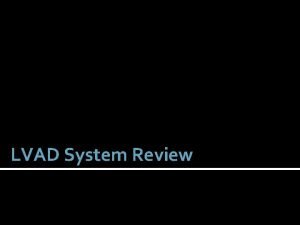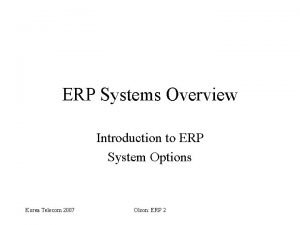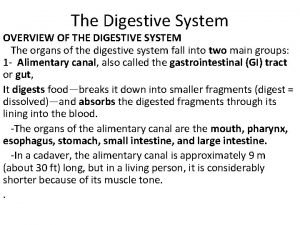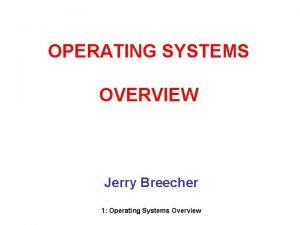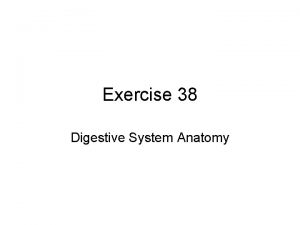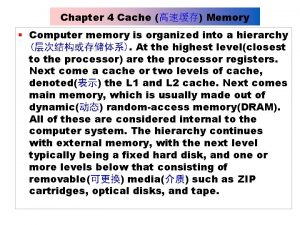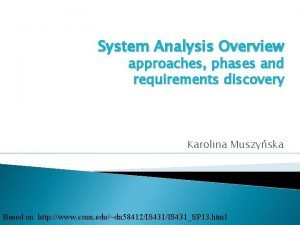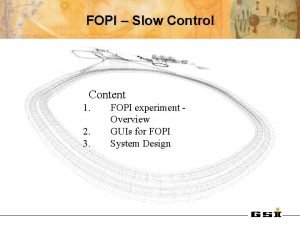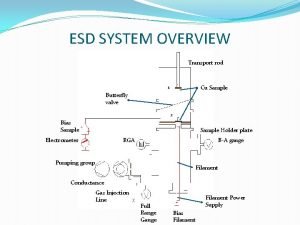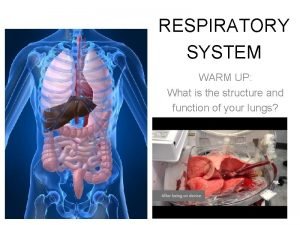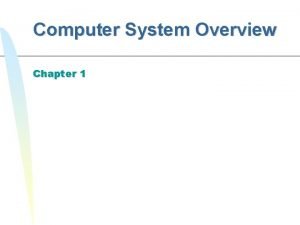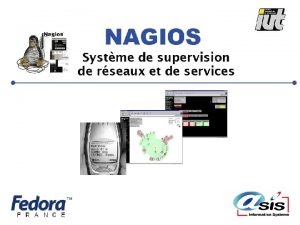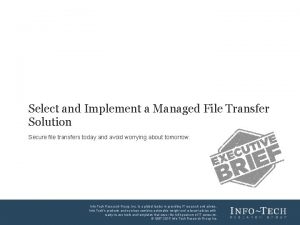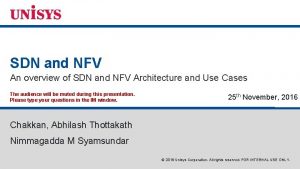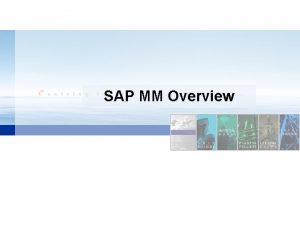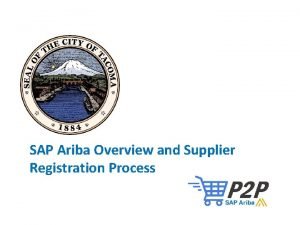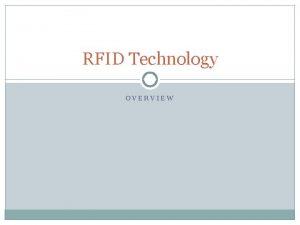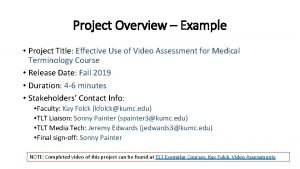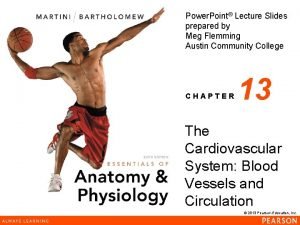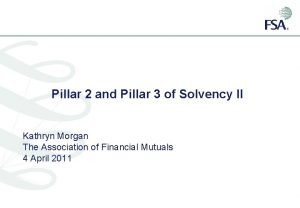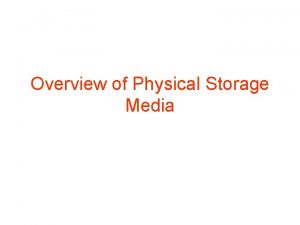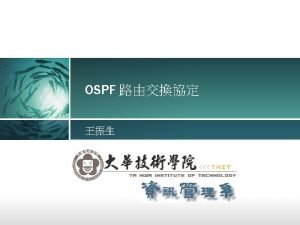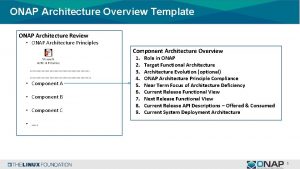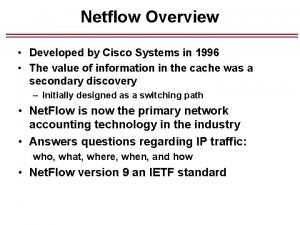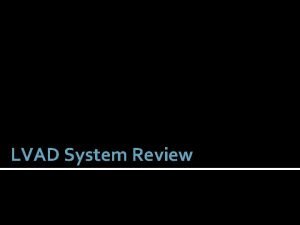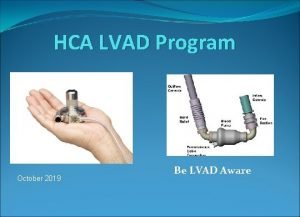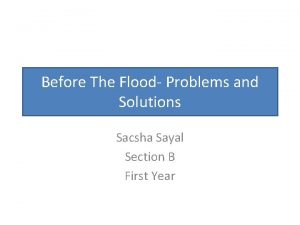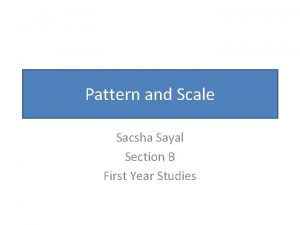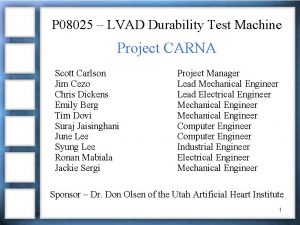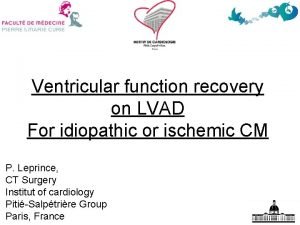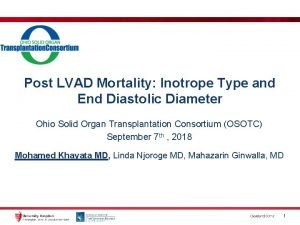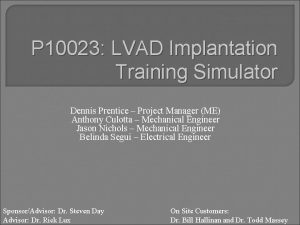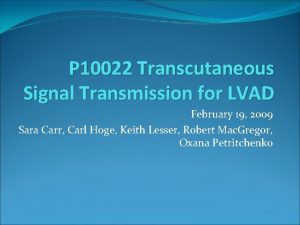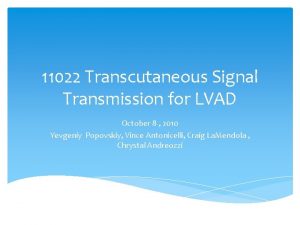LVAD System Review System Overview Smiha Sayal System



























































- Slides: 59

LVAD System Review

System Overview Smiha Sayal

System Overview �Left Ventricular Assist Device (LVAD) Mechanical device that helps pump blood from the heart to the rest of the body. �Implanted in patients with heart diseases or poor heart function.

System Goal Miniaturize the existing LVAD system to achieve portability while retaining its safety and reliability.

Original System “Black box” architecture used during development Large, not portable Runs on AC power

P 10021’s System �Has both internal / external components �Equivalent to our “Option 2” �Unfinished implementation

Customer Needs Safe Robust Affordable Easy to wear and use Interactive with user Controllable by skilled technician Comparable performance Compatible with existing pump

Other LVAD Technologies Cor. Aide (NASA)

Other LVAD Technologies

Concepts: Option 1 All electronics external

Concepts: Option 2 ADC internal only

Concepts: Option 3 Pump and motor control internal

Concepts: Option 4 All electronics and battery internal

Concepts: Option 5 All electronics and battery internal

Concept Generation

Concept Generation Highlights Option 1 Be Op st tion Option 2 • Smallest internal volume • Feasible within timeline • Easiest to maintain • Minimum 20 wires 350 • Relatively small internal volume • Slightly higher risk of internal failure • Minimum 10 wires Option 3 Option 4 • Large internal volume • Difficult to design • Electronics failure is fatal • Minimum 3 wires 200 • Large internal volume • Difficult to design • Electronics failure is fatal • Minimum 3 wires Option 5 • Relatively small internal volume • Slightly higher risk of internal failure 249 • Minimum 273 153

Enclosure Design Nicole Varble and Jason Walzer

External Enclosure Needs The external package should be lightweight/ robust/ water resistant The devices should be competitive with current devices The device should fit into a small pouch and be comfortable for user and be comfortable for the user The external package should resist minor splashing The device should survive a fall from the hip Housing for the electronics is too heavy/large/uncomfortable Water can enter the external package and harm the electronics The housing fails before the electronic components in drop tests The electronic components can not survive multiple drop tests Risks

Concept Generation- Materials/Manufacturing Process Concept Generation- Material and Manufacturing Processes Rapid Prototyping (ABS Plastic) Stereolithography Injection Molded Machine Metal or Polymer Selection Criteria Weight Rating Notes Score Cost 9 4 36 1 9 1 $30 k for mold 9 2 18 Feasibility within timeline 10 5 50 4 long lead time 40 1 10 3 30 Strength 6 4 37 MPa 24 5 58 MPa 30 5 35 -70 MPa 30 5 ~580 MPa 30 Material Interaction with water 4 2 8 4 resin based 16 5 20 4 16 Ease of Manufacturing 3 5 15 3 9 0 0 20 wires 0 10 wires 0 3 wires 0 Net Score 133 110 78 103 Rank 1 2 3 4 Continue? yes No no no weight 1 - low importance 10 - high importance rating 1 - does not meet cirteria 5 - meets cirteria

Rapid Prototyping Machinable Material can be drilled and tapped (carefully) Accepts CAD drawings Complex geometries can be created easily Ideal for proposed ergonomic shape Builds with support layer Models can be built with working/moving hinges without having to worry about pins • Capable of building thin geometries • ABSplus – Industrial thermoplastic • Lightweight - Specific gravity of 1. 04 • Porous – Does not address water resistant need http: //www. dimensionprinting. com/

ABS Plastic Mechanical Property Test Method Imperial Metric Tensile Strength ASTM D 638 5, 300 psi 37 MPa Tensile Modulus ASTM D 638 330, 000 psi 2, 320 MPa Tensile Elongation ASTM D 638 3% 3% Heat Deflection ASTM D 648 204°F 96°C Glass Transition DMA (SSYS) 226°F 108°C Specific Gravity ASTM D 792 1. 04 Coefficient of Thermal Expansion ASTM E 831 4. 90 E-5 in/in/F • Important Notes • Relatively high tensile strength • Glass Transition well above body temperature • Specific Gravity indicates lightweight material

Feasibility- Water Ingress Test Need: The external package should resist minor splashing Specification: Water Ingress Tests Once model is constructed, (user interface, connectors sealed, lid in place) exclude internal electronics and perform test Monitor flow rate (length of time and volume) of water Asses the quality to which water is prevented from entering case by examining water soluble paper Risk: Water can enter the external package and harm the electronics Preventative measures: Spray on Rubber Coating or adhesive O-rings around each screw well and around the lid Loctite at connectors Preliminary Tests without protective coating show no traceable water ingress Loctite Spray on Rubberized Coating

Feasibility- Robustness Testing Need: The device should survive a fall from the hip Specification: Drop Test Goal Show the housing will not fail Show electronics package will not fail, when subjected to multiple drop tests Risks The housing fails before the electronic components in drop tests (proved unlikely with prototype enclosure) The electronic components can not survive multiple drop tests Eliminate snap hinges from housing (tested and failed) Test the housing first Design a compact electronics package Drop external housing 3 times from 1. 5 m, device should remain fully intact Specify and build internal electrical components Identify the “most vulnerable” electrical component(s) which may be susceptible to breaking upon a drop Mimic those components using comparable (but inexpensive and replaceable) electrical components, solder on point to point soldering board Preventative Measures

Feasibility- Heat Dissipation of Internal Components 130°C is absolute maximum for chip junction temperature in order to function properly Goal- comfort for the user Assumed steady state, heat only dissipated through 3 external surfaces Maximum heat dissipation ~25 W Actual heat dissipation ~5 W Tout Tin Q h 250 Internal Temperature [°C] 200 Tout= Room 150 Tout = Body 100 Absolute Max Temperature 50 0 t, k 0 10 20 30 Heat Generation, Q [W] 40

Prototype Enclosure Survived drop test Water resistant Plastic is machinable Drilled, tapped, milled Helicoils should be used to tap holes Constant opening and screwing and unscrewing of lid will result in stripped threads Approximate wall thickness (6 mm) Distance between center of holes and wall needs to be increased Some cracking occued Latches are not feasible

User Interface To Battery MENU Speed Battery Life Fault Indication Components: Indication of battery life (3 x LED) Indication of Fault (LED and Buzzer) Indication of levitation (LED) Display Increase/Decrease Speed (2 x Button) Menu (Button) + - BATTER Y OK ERROR From Pump To/From Computer Connectors: 26 - pin LEMO connector USB connector Battery Terminals (x 2) OK: Indication of levitation ERROR: No Levitation, connection errors

User Interface- Components LED Backlit display with waterproof bezel and o-ring G/R/Y LEDs with O-ring and waterproof bezel Waterproof buttons with O-ring

User Interface- Connectors Current Model: Part # EGG 2 K 326 CLL Proposed: Part # EEG 2 K 326 CLV Pin Layout

User Interface- IP Codes IP Ingress Protection First Number Protection against Solid Objects 0 - No protection (Sometimes X) 1 - Protected against solid objects up to 50 mm³ 2 - Protected against solid objects up to 12 mm³ 3 - Protected against solid objects up to 2. 5 mm³ 4 - Protected against solid objects up to 1 mm³ 5 - Protected against dust, limited ingress (no harmful deposit) 6 - Totally protected against dust Second Number Protection against liquids 0 - No protection (Sometimes X) 1 - Protection against vertically falling drops of water (e. g. condensation) 2 - Protection against direct sprays of water up to 15 degrees from vertical 3 - Protection against direct sprays of water up to 60 degrees from vertical 4 - Protection against water sprayed from all directions - limited ingress permitted 5 - Protected against low pressure jets of water from all directions - limited ingress permitted 6 - Protected against low pressure jets of water, limited ingress permitted (e. g. ship deck) 7 - Protected against the effect of immersion between 15 cm and 1 m 8 - Protected against long periods of immersion under pressure Display IP 67 Buttons IP 67 LEDs IP 67 USB IP 68 Connector IP 68

Enclosure Design

Enclosure Design

Enclosure Design

Embedded Control System Andrew Hoag and Zack Shivers

Control System Requirements Selecting suitable embedded control system Designing port of control logic to embedded system architecture Customer Needs Device is compatible with current LVAD Device is portable/small Allows debug access

Impeller Levitation � Impeller must be levitating or “floating” � Electromagnets control force exerted on impeller � Keeps impeller stabilized in the center � Position error measured by Hall Effect sensors

Levitation Algorithm �Algorithm complexity influences microcontroller choice Electronics choices affect volume / weight �Proportional – Integral – Derivative (PID) Very common, low complexity control scheme http: //en. wikipedia. org/wiki/PID_controller

Embedded System Selection Requirements: Can handle PID calculations Has at least 8 x 12 -bit ADC for sensors at 2000 samples/sec Multiple PWM outputs to motor controller(s) Same control logic as current LVAD system Reprogrammable

Embedded System Selection Custom Embedded ds. PIC Microcontroller ▪ Blocks for Simulink ▪ Small ▪ Inexpensive (<$10 a piece) TI MSP 430 ▪ Inexpensive (<$8 a piece) ▪ Small, low power COTS Embedded National Instruments Embedded ▪ Uses Lab. VIEW ▪ Manufacturer of current test and data acquisition system in “Big Black Box” ▪ Large to very large ▪ Very expensive (>$2000)

Control Logic/Software Closed-loop feedback control using PID – currently modeled in Simulink for use with the in “Big Black Box” Additional microcontroller -specific software will be required to configure and use A/D, interrupts, timers.

Life Critical System Not at subsystem level detail yet. Life-critical operations would run on main microcontroller. User-interface operations run on separate microcontroller. Possible LRU (Least Replaceable Unit) scheme

Separation of Main/UI Microcontroller Concept Selection

Technician/Field Software Debug Interface USB Serial (RS-232) USB is everywhere. Requires custom PC-side software. Requires processor support. Many computers don’t have serial ports anymore. ▪ Can use $15 COTS USB to Serial adapter. Can use COTS terminal tools.

Technician/Field Software Debug Interface Example of using COTS tool – Windows Hyper. Terminal (free/part of Windows)

Technician/Field Software Debug Interface Concept Selection

Microcontroller Search Parameters A/D 0 -5 V 8 x 12 -bit @5 ksps (kilo-samples/sec) ▪ This equates to 40 ksps minimum for A/D PWM General I/O for UI controls At least 10 x digital At least 5 x analog UART (for Serial connection)

Microcontroller Packaging L/TQFP – Low-profile/Thin Quad Flat Pack Small surface-mount (PCB mount) chip package. Is solderable (by skilled solderer) Body thickness up to 1. 0 mm, sizes range from 5 x 5 mm to 20 x 20 mm

Microcontroller 2 families of Microcontrollers ds. PIC from Microchip MSP 430 from Texas Instruments

Microchip ds. PIC 30 F 5011 (16 -bit architecture) Max CPU speed 30 MIPS (Million Instructions/sec) 2. 5 -5. 5 V operating voltage 66 KB Flash, 4 KB RAM, 1 KB EEPROM 16 x 12 -bit ADC @ 200 ksps -40 to 85 C operating temp 64 -lead TQFP – body 10 x 10 mm, overall 12 x 12 mm Cost [1 -25 units] = $7. 21

TI MSP 430 F 5435 A (16 -bit architecture) Max CPU speed 25 MIPS (Million Instructions/sec) 2. 2 -3. 6 V operating voltage 192 KB Flash, 16 KB RAM 16 x 12 -bit ADC @ 200 ksps 3 Timer modules (with total of 15 timer channels) -40 to 85 C operating temp 80 -lead LQFP – body 10 x 10 mm, overall 12 x 12 mm

Microcontroller Concept Selection

Active Magnetic Bearings System Ampliers Juan Jackson

AMB Control Center The control center is a closed loop system Stabilization of system is achieved by the feedback control Power Amplifiers convert the input PWM signals to satisfy system requirements PWM Control Signal 4 H-Bridge or 2 Full Bridge Power Amplifiers Active Magnetic Bearing System DAC Rear. X Front. X Impeller Rear. Y Front. Y Hall Effect Sensors (Senses Position) Microcontroller Four Degrees of freedom, Front. X, Front. Y, Rear. X, Rear. Y, which pushes rotor

Amplifier Selection 2 types to select from Linear ▪ Output input ▪ Higher power to load PWM ▪ The generated current switches between output high and low ▪ Capable of higher power than the linear amplifier ▪ Better performance at higher frequencies

Amplifier Selection Linear Amplifier Selection Criteria Weight PWM Amplifier Rating Cost Notes Score Rating Notes Score 5 3 15 5 25 Feasibility within timeline 10 5 50 Fits Customer Requests 10 2 20 5 50 6 4 24 149 Ease of Design Net Score Weight 1 -Low importance 10 -High importance Rating 1 -Does not meet criteria 5 -Meets criteria 109

Amplifier Selection 11021 Selection Criteria Weight Continuous Current Output (A) Switching Frequency (k. Hz) Rdson (mΩ) Operating Supply Voltage (V) Temperature (°C) Package Type Net Score Rank Designer Choice Customer Choice 10 AMB Amplifier Selection TLE 6209 R LMD 1800 Specification Notes DRV 8412 Rating Score Specification. Notes Rating Score Specification Notes Operation with current system 3 verified 5 50 3 5 50 6 Rating Score 5 50 10 10 100 330 5 2 50 20 2000 150 5 5 50 50 500 80 5 5 50 50 10 12 to 55 5 50 up to 45 5 50 50 -40°C ~ 150°C 5 50 -40°C ~ 85°C 5 50 16 236 2 Surface mount 2 ND 5 40 290 1 1 st 3 RD 5 40 290 1 10 8 -40°C ~ 125°C Through hole 3 RD 1 st 5 2

Amplifier Selection Proof of concept Texas Instrument Application Diagram for Full Bridge Mode Operation

Amplifier Selection Proof of concept Motor Control - DC Brushless BLDC motors are more efficient, run faster and quieter, and require electronics to control the rotating field. BLDC motors are also cheaper to manufacture and easy to maintain Recommended: MSP 430 F 5438 Also consider: Stellaris 5000 /8000 Series C 2000 - Fixed Point / Piccolo, Delfino MSP 430 - F 2 xx /5 xx 25 MHz ADS 7953 - 1 ch, 12 bit ADC BQ 2000 T - Battery Charge Management SN 65 HVD 233 - 3. 3 V CAN Transceiver TPS 40305 - DC/DC Controllers DRV 8412 - PWM Power Driver TPS 54620 - Step. Down Regulators Texas Instruments Microcontroller for Motor Control Applications : Component recommendation "MCU 4 Analog. " Texas Instruments, n. d. Web. 4 Nov 2010. <http: //focus. ti. com/mcu/docs/mcuorphan. tsp? content. Id=73295&DCMP=MCU_other&HQS=Other+OT

Amplifier Selection Proof of concept Testing Hardware

Questions / Comments Help us improve our design!
 Sayal usb
Sayal usb Aseem sayal
Aseem sayal Chapter review motion part a vocabulary review answer key
Chapter review motion part a vocabulary review answer key Ap gov review final exam review
Ap gov review final exam review Nader amin-salehi
Nader amin-salehi Systematic review definition
Systematic review definition Narrative review vs systematic review
Narrative review vs systematic review Erp system introduction
Erp system introduction Content management system overview
Content management system overview Role of computer accounting
Role of computer accounting Overview of the digestive system
Overview of the digestive system Crtd sap
Crtd sap Operating systems overview
Operating systems overview Scope of gym management system project
Scope of gym management system project Duodenum
Duodenum Computer memory system overview
Computer memory system overview Computer memory system overview
Computer memory system overview British school system presentation
British school system presentation Chapter 2 an overview of the financial system
Chapter 2 an overview of the financial system British school system overview
British school system overview System design overview
System design overview System design overview
System design overview System overview sample
System overview sample Lpi
Lpi 3 lobes of lung
3 lobes of lung Computer system overview
Computer system overview Www.overview
Www.overview Maximo work order priority
Maximo work order priority Universal modeling language
Universal modeling language Uml
Uml Vertical overview
Vertical overview Figure 12-1 provides an overview of the lymphatic vessels
Figure 12-1 provides an overview of the lymphatic vessels Overview of the major systemic arteries
Overview of the major systemic arteries Texas recapture districts
Texas recapture districts Walmart inventory management systems
Walmart inventory management systems Stylistic overview of painting
Stylistic overview of painting Sa/sd vs jsd
Sa/sd vs jsd Spring framework overview
Spring framework overview Nagios tactical overview
Nagios tactical overview Market overview managed file transfer solutions
Market overview managed file transfer solutions Nfv vs sdn
Nfv vs sdn Sbic program overview
Sbic program overview Sap consignment process
Sap consignment process Sap ariba overview
Sap ariba overview Safe overview
Safe overview Rfid technology overview
Rfid technology overview Review paper introduction
Review paper introduction Perbedaan replikasi virus dna dan rna
Perbedaan replikasi virus dna dan rna Example of project title
Example of project title Major systemic arteries labeled
Major systemic arteries labeled Summary vs abstract
Summary vs abstract Solvency 2 pillar 2
Solvency 2 pillar 2 Physical storage media
Physical storage media Overview of education in health care
Overview of education in health care Overview funding programmes
Overview funding programmes Ospf overview
Ospf overview Onap architecture overview
Onap architecture overview Oedipus rex timeline
Oedipus rex timeline Cisco top talkers
Cisco top talkers Ntep organogram
Ntep organogram
